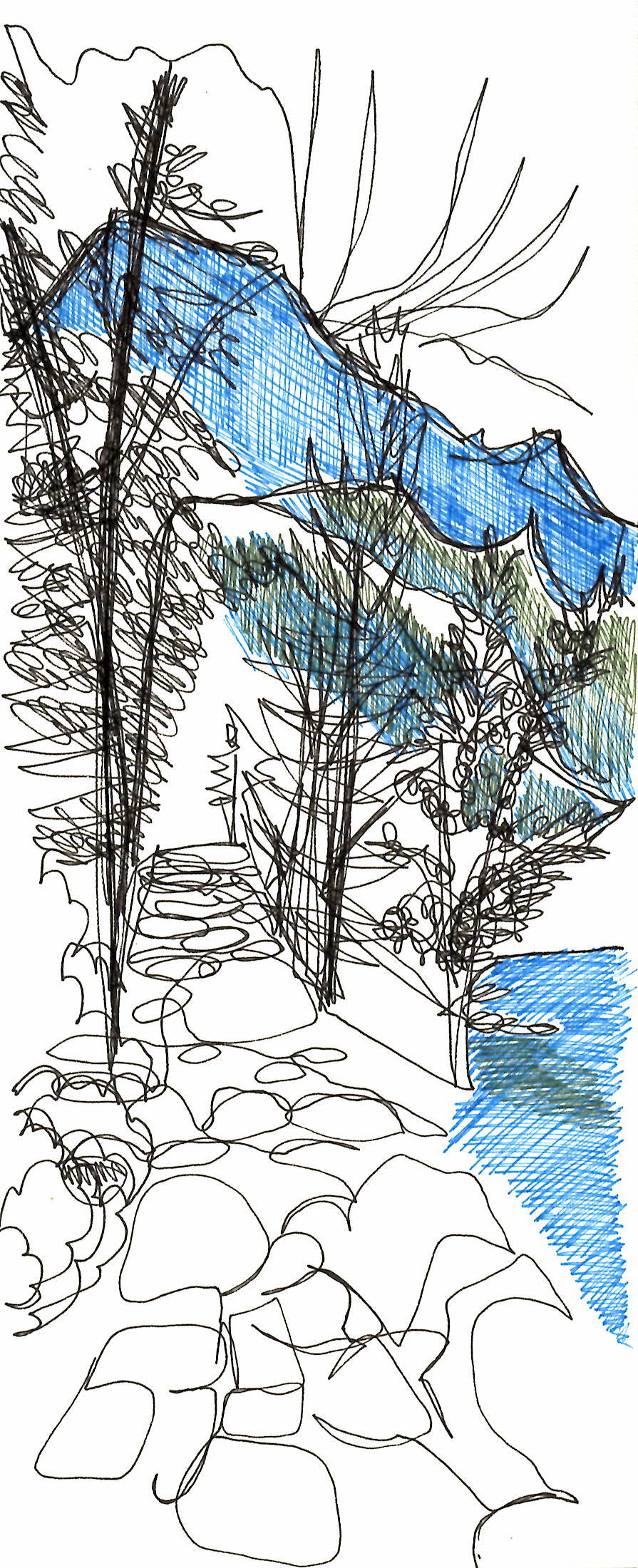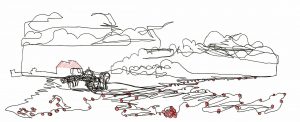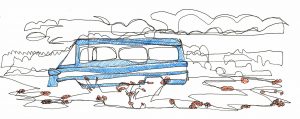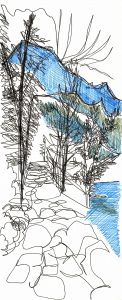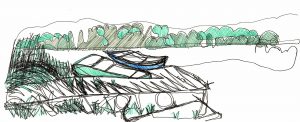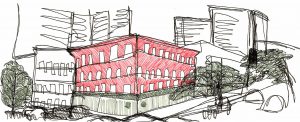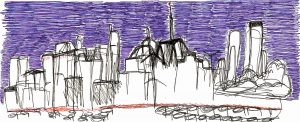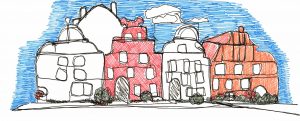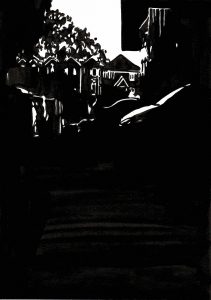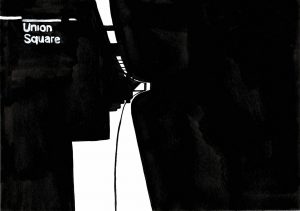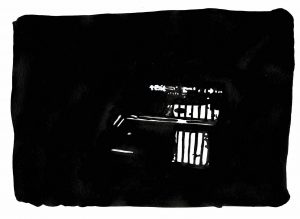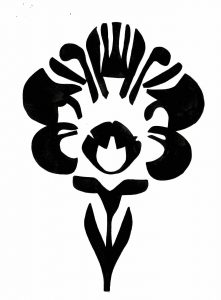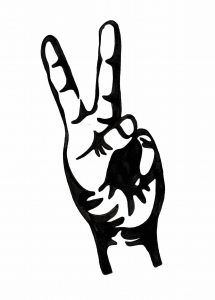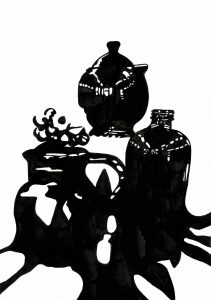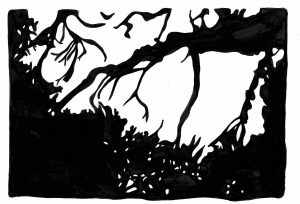Studio 2 and Seminar 2:Visual Culture
Bridge Project 2:
Studio – 2 Rules, 14 Drawings – 7 Days of Drawing
Seminar – Six Day Journal
Studio
7 Days of Drawing
Set One: 11in x 4.5in
-rule 1:All must be landscapes and must have at least 2-3 colors
-rule 2:All must be blind contour/continues line
Set Two: 8.5in x 6in
-rule 1:Take a picture of anything or anyone around and use illustrator to ‘Image Trace’ to black and white
-rule 2: Paint the pictures only with india ink
Reflection:
For my 7 Days of Drawing I decided to challenge myself with the rules. By deciding these materials specifically I gave myself boundaries and in the end really liked the outcome. I have worked minimally with India ink and contour drawing therefor it was nice to work with something I’m not too experienced with to get some practice in and learn a few things about the material itself along the way.
Seminar
Six Day Journal
02/03/18
Q: Can you teach art? Can you teach someone to be creative? How?
A: Teaching art is something that can be either easy or hard and like with any other subject that we can teach it all depends on the person learning it. Before I began Parsons, I used to be an art instructor at a studio in Staten Island. I taught children of all ages and helped out in other more advanced classes. Knowing art (painting, drawing, gradation, colors, etc.) has allowed me to be able to teach it very easily because I knew what to do and what steps to show people if they got stuck or didn’t know how to draw something or someone. I knew how to show them so that they could do it and learn it themselves. To be ale to teach art you have to know it first yourself. Physically you need to be able to know how to illustrate something first because if you are to teach it to someone else you need to a verity of ways to be able to explain a process to them. Sometimes someone won’t understand you the first time and you have to explain in a different way. However, art physically and creativity are two different aspects of design. I believe that everyone is creative in their own way. They have different ways that they express themselves but not everyone can express themselves artistically through painting, drawing, etc. I don’t think you can teach someone to be creative but teach them to expand their creativity. You can teach people to think in different ways and approach different projects and situations by thinking and looking at objects and people in various perspectives. Creativity is what ignites inspirations and solutions to design and it is a portion of what we do to come up with ideas. As a result IT have to believe that art and creativity are two very different things because you can teach art but sometimes people don’t find it to be their passion or something that their “good” at, however creativity is something that we all have and is a way of thinking that anyone can expand to their benefit.
02/04/18
Q: With Barthes in mind, think about “Mythologies” that you encounter everyday. This could be as specific as an advertisement or a food you eat for breakfast, or as board as a snap judgment or stereotype you find yourself making.
A: After reading Barthes’s “Preface” and “Wine and Milk” and our discussion in class about the “Mythologies” of our everyday lives I’ve opened me eyes to the stereotypes that we as a society have implanted on each other individually and on groups as well as even on objects such as food, toys, technologies, etc. Today ironically, I had focused myself on the mythologies of fast food industries. As I ate a box of small fries from Wendy’s I couldn’t help but think about today’s political rivalry between fast food chains and the government’s health policies that warn against obesity and health issues that involve more than one of your functioning organs. Although very delicious and cheap as a matter of fact, I can’t help agree that eating fries soaked in oil is a completely different feeling compared to eating freshly baked potatoes. Today the cons of fast food is constantly advertised in schools to children and their parents and it is slowly drilled into our brains that eating healthy is the best way to live. However, the minute we get home advertisements of those puffy fries and big fresh burgers and chilly soft drinks in cups show up on your tv encouraging us to have a bite. In America the fast food industry is thriving from Wendy’s to McDonalds and Burger King we have plenty of unhealthy food choices to make but they don’t have to be this unhealthy. Imagine eating a burger that’s just as fresh as if you had made it at home. Seeing as my parents are originally from Poland which is in Europe I’ve had the crazy experience of being able to eat the same fast food that’s here in America there, including Mickey D’s. In many European countries food and health laws require restaurants including fast food companies to use fresh foods and regulated produce. In Poland I walked into McDonalds and ordered a grilled chicken wrap and coffee to have it handed to me in a mug and a plate. I also went out to the market place by my parents home town and sat and ordered pizza from Pizza Hut. My family and I settled outside and we received freshly baked pizza with thin crusts and toppings of every kind. Fast food literally means quick food that can be taken on the go but it doesn’t have to mean that it has to be unhealthy for us.
02/05/18
Q: If you owned a gallery, what kind of art would you display? Would your gallery have a theme?
A: Owning an art gallery is owning a business and it’s one of the careers that I’ve looked into more than once and considered while applying to college. An art gallery displays artwork and I think one of the most interesting and important parts of a gallery is the fact that the owner is the person who sets the tone of what kind of art is displayed, sold and what kind of artists exhibit their designs to show the public what their artistic eyes see. If I were to own a gallery I would be most interested in showing realistic paintings and drawings. As an artist my own art is extremely realistic. I love doing portraits, landscapes and still life. I’ve always loved being about to capture what I see in front of myself in a 2D form. To me it’s like capturing a moment in time but not as a photograph. If I had a gallery I would focus on finding artists who do realism because this is a form of art that I feel has died down over the decades and is now rare. Realistic art fascinated me because I’m a fanatic when it comes to detail. Precision is something that I strive for in my artwork and don’t mind taking the time to do it. Therefore, I appreciate artists like myself who take the time to notice the details and the little things in the people, objects and places around us. Although I like realistic art the general theme of my gallery would be international. I would look for artists of all ages and from all around the world. For art and design that would show a hint of culture and diversity. I would look for art that would make me stop and do a double take or just purely draw me in to stare at it for hours. The kind of art that I really love is the type that really makes me smile and think, and that shows creativity.
02/06/18
Q: How would you describe your art to your family member? How would you describe your favorite artist to this same person?
A: Describing my art to a family member is actually a little bit harder than one might think. Usually describing my art comes easily to me. I know my style, what I strive to achieve and what inspires me. However, my family is Polish and although I’m fluent in the language I sometimes can’t help but stumble on my words as I try to translate my thoughts to be able to explain to my family members that they are the inspiration behind my pieces. Although I am a landscape artist many of the landscapes that I do are from Poland. Major cities and favorite places that I like to see everytime that I visit. Even though I was born right here in Brooklyn, New York I’m extremely tied down to my polish roots. I’ve gone to and graduated from Polish School, I’m a member of the Polish Scouting Organization here in America called ZHP and I am in love with history, more specifically Polish history. Many times this shocks my relatives but in the end they are always happy to see that I care so much about this nationality. Therefore, at the sametime if I were to describe my favorite Polish artist to them then they wouldn’t be too confused or shocked if I said it were Jan Matejko. Not only was Matejko in a way a historian of Polish history but he was an artist who did realism and had an amazing eye for detail. I like to think of myself as an artist and designer but at the sametime some kind of historian. I have a passion for art and art history and I love to share it with my family even if it does mean getting over a small language barrier.
02/07/18
Q: Describe your ideal place to live and to work. Describe the design of your ideal studio.
A: My ideal place to live and to work would be in a city. As a native New Yorker I’ve grown up used to the bustle, rush and atmosphere that comes from these grand places. Cities are alive day and night and that is only one factor that draws me into them. In major places you meet people everyday, some of which you’ll only see once in your life and some with which you’ll make the greatest connections. Just today as I walked through Battery Park taking pictures for my Photography concepts class I meet a couple whose pictures I took and we chatted before exchanging emails. I can’t say that the city sometimes doesn’t get overwhelming because that’d be a lie. Sometimes getting out of busy Manhattan is the best thing to do. I love camping, the suburban parts of Staten Island were I currently live and walks in the park were you can’t hear anything but birds chirping. But even then after sometime I’m always dying to get back to where I was before. It’s weird going to sleep without the sound a lively city outside your window. Therefore, I wouldn’t want my studio to be anywhere else but where the hustle and bustle is. My ideal studio isn’t completely in a building, its the people and buildings outside of the small room in which I do my artwork. I love going out and photographing people, objects, and landscapes and then turning my pictures into pieces. My ideal studio can also be any place in which I feel comfortable. I could be drawing on a bench in Union Square and be content with where I am as long as I have all my materials.Something that I’ve been dying to do ever since I was younger is travel around the world to our most remarkable and famous cities and be able to sketch and draw my favorite things about each one of them right there on the spot.
02/08/18
Q:What makes something art? Have you ever seen something on the street and though it was public art, only to realize it wasn’t?
A: My definition of art is any piece of physical and even now a days, digital work in which there is an emotion and meaning; a purpose behind expression. Art is something that is actually represented in many forms and I consider it to be, in a way a record of history. Many artists have recorded major events that have happened throughout history but most importantly their work is a piece by piece show of our evolution as humans. Starting from the early cave paintings to the realistic paintings, photographs and even sculptures that we have today, it is clear to me that art is a physical documentation of our advancement and the growth of our knowledge. In a single art piece you can see generations of studies of anatomies, landscapes, color, etc. However something that I have always found interesting is the fact that thousands of years from the first cave paintings we are still using the streets and public places to create art. Street art is a form of expression that I most definitely consider to be real art. From graffiti and tagging to literal paintings on the ground that make you feel like you’ve stepped into the work yourself. There are moments in the streets when I find myself wondering what all these building would look like if there was no such thing as public art and I can’t help but think that it’d be a pretty boring atmosphere. Most street art brings the city to life and for me where I’m here in NYC or even in my home town in Poland stumbling upon that one piece of street are is always interesting. I think that a lot of people don’t realize that some of the greatest artists started out on the streets, one of which that everyone knows is Banksy. There are many times that I walk past a building and think that I’m looking at public art that has been designed to be there when really I’m looking at an artist who just made a true masterpiece.
